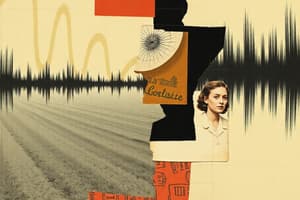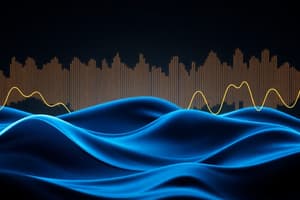Podcast
Questions and Answers
What is the fundamental frequency in relation to pitch perception?
What is the fundamental frequency in relation to pitch perception?
- The lowest frequency in a sound (correct)
- The highest frequency in a sound
- A combination of multiple frequencies
- The average frequency of all harmonics
What phenomenon allows us to perceive pitch even in the absence of the fundamental frequency?
What phenomenon allows us to perceive pitch even in the absence of the fundamental frequency?
- Pitch shifting
- Harmonic resonance
- Frequency modulation
- Missing F0 phenomenon (correct)
Which of the following components is NOT considered a perceptual component of music?
Which of the following components is NOT considered a perceptual component of music?
- Volume (correct)
- Pitch
- Rhythm
- Harmony
What key aspect is associated with the spatial component in music perception?
What key aspect is associated with the spatial component in music perception?
Which of the following statements best describes the relationship between pitch and harmonics?
Which of the following statements best describes the relationship between pitch and harmonics?
What defines the concept of 'beat' in auditory rhythms?
What defines the concept of 'beat' in auditory rhythms?
What is the effect of tempo on rhythm perception?
What is the effect of tempo on rhythm perception?
Which range defines the optimal temporal integration window for perceiving rhythm?
Which range defines the optimal temporal integration window for perceiving rhythm?
Which of the following is NOT a core feature of rhythms in music perception?
Which of the following is NOT a core feature of rhythms in music perception?
What is meant by 'perceived metre' in music perception?
What is meant by 'perceived metre' in music perception?
Which theory focuses on how intervals of time are perceived through a running count?
Which theory focuses on how intervals of time are perceived through a running count?
What does the entrainment theory involve?
What does the entrainment theory involve?
In the context of interval theories, what would be compared to judge time?
In the context of interval theories, what would be compared to judge time?
How do humans judge time according to entrainment theory?
How do humans judge time according to entrainment theory?
What is a significant function of rhythmic neural firing patterns?
What is a significant function of rhythmic neural firing patterns?
What is the primary role of hair cells in the auditory system?
What is the primary role of hair cells in the auditory system?
Which of the following best describes the auditory nerve's function?
Which of the following best describes the auditory nerve's function?
What is a key function of binaural hearing?
What is a key function of binaural hearing?
Which method is NOT used for locating sounds in space?
Which method is NOT used for locating sounds in space?
The sensory integration mechanism in the auditory system facilitates which of the following responses?
The sensory integration mechanism in the auditory system facilitates which of the following responses?
Which structure is critical for the convergence of auditory information before reaching the primary auditory cortex?
Which structure is critical for the convergence of auditory information before reaching the primary auditory cortex?
What kind of coding is represented along the basilar membrane in the auditory system?
What kind of coding is represented along the basilar membrane in the auditory system?
Which statement regarding the neural pathways of sound is FALSE?
Which statement regarding the neural pathways of sound is FALSE?
What physical property of sound is measured in Hertz (Hz)?
What physical property of sound is measured in Hertz (Hz)?
Which part of the ear is involved in the transduction of sound waves?
Which part of the ear is involved in the transduction of sound waves?
Which physical property correlates with the perception of loudness?
Which physical property correlates with the perception of loudness?
What is the role of the Head-Related Transfer Function in auditory perception?
What is the role of the Head-Related Transfer Function in auditory perception?
What is the primary task of the auditory system?
What is the primary task of the auditory system?
Which structure connects the middle ear to the cochlea?
Which structure connects the middle ear to the cochlea?
How does frequency influence pitch perception?
How does frequency influence pitch perception?
Which of the following best describes the role of the ossicles in the middle ear?
Which of the following best describes the role of the ossicles in the middle ear?
What is the measure of perceived loudness in phon units?
What is the measure of perceived loudness in phon units?
Why can't sound waves just hit the cochlea directly?
Why can't sound waves just hit the cochlea directly?
Flashcards are hidden until you start studying
Study Notes
Sound and Auditory Perception
- Sound is a physical phenomenon consisting of compressions and rarefactions of air molecules.
- Sinusoidal sound waves are a visual representation of sound with peaks (compression) and troughs (rarefaction).
- Frequency is the number of cycles per second (Hz) and corresponds to pitch.
- Frequency is the perceptual correlate of pitch
- Amplitude is the height of the sound wave and corresponds to loudness.
- Amplitude is the perceptual correlate of loudness.
- Equal loudness contours illustrate the relationship between frequency and intensity and how they influence perceived loudness.
- Phon is a unit of loudness perception.
Sound Processing in the Ear
- Outer, middle, and inner ear work together to covert sound waves into an electrical signal.
- Outer ear structures (like ear canal and pinna) shape the incoming sound.
- Middle ear contains three tiny bones (malleus, incus, stapes) that amplify and transfer the sound vibrations from the eardrum to the oval window.
- Inner ear contains the cochlea, a fluid-filled tube with the basilar membrane inside.
- Hair cells on the basilar membrane transduce the mechanical vibrations into an electrical signal.
- Auditory Nerve carries the electrical signal from the hair cells to the brain.
Neural Pathway of Sound
- Auditory nerve transmits auditory information to the cochlear nucleus in the brainstem.
- Superior olivary complex is important for binaural hearing (sound localization) and processes interaural time difference and interaural level difference.
- Inferior colliculus integrates auditory information from the ears and other sources.
- Medial geniculate nucleus in the thalamus relays incoming auditory information to the primary auditory cortex in the temporal lobe.
Auditory Scene Analysis
- Auditory scene analysis refers to how we perceive distinct sounds in a complex auditory environment.
Core Music Features
- Pitch is the perceptual quality of how high or low a sound is. It relies on the fundamental frequency of the sound.
- The missing fundamental frequency phenomenon demonstrates that we can still perceive pitch when the fundamental frequency is absent.
- Rhythm is the perception of how sounds are organized in time.
- Key components of rhythm in music perception: tempo, beat, and meter.
- Tempo refers to the speed of the rhythm (number of beats per minute).
- Beat is a perceived regular time point in a rhythmical sequence which is consistent with the tempo.
- Meter is a hierarchical pattern of stressed and unstressed beats.
Theories of Music Perception
- Interval theories propose that we perceive time by comparing the duration between intervals of sound.
- Entrainment theories suggest that rhythmic neural activity is synchronized with the auditory rhythm.
Recap
- This lesson explored the physics of sound and how it is processed by the ear and brain.
- We learned about the key components of music perception, including pitch, rhythm, tempo, beat and meter.
- We learned about two prevalent theories for explaining sound perception and rhythm perception.
Studying That Suits You
Use AI to generate personalized quizzes and flashcards to suit your learning preferences.




